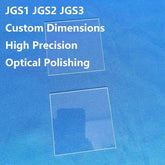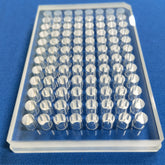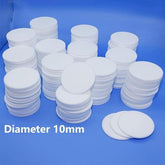How can quartz lenses be produced without bubbles or cracks?
Quartz lenses represent the most widely used basic component in optical instruments and find extensive application in scientific research, manufacturing and medical fields. Due to its outstanding performance in optical properties, physical characteristics, chemical inertness and other aspects, the manufacturing technology of quartz lenses has become increasingly mature, and the market demand for quartz lenses is also constantly expanding. However, issues such as bubbles and cracks frequently arise during the manufacturing process of quartz lenses. The implementation of this measure will not only have a detrimental effect on the quality of quartz lenses, but will also increase manufacturing costs and lead to a waste of production time and materials. This article will discuss how to avoid bubbles and cracks in quartz lenses.
1. The selection of raw materials
The quality of quartz lenses is significantly influenced by the quality of the raw materials, as quartz lenses are manufactured using quartz stone. The raw materials should be of the highest quality, with the characteristics of high purity, low gas content, a uniform structure and no impurities. When selecting raw materials, it is essential to enhance inspection procedures, with a particular focus on ensuring the gas and impurity content is thoroughly checked. It is imperative that raw materials which do not meet the required standards are eliminated. The selection of high-quality raw materials is pivotal in ensuring the quality of quartz lenses, thereby minimizing the occurrence of bubbles and cracks.

2. The treatment of quartz raw materials
Following a chemical analysis and physical external inspection of the raw materials, they should be cleaned first. When cleaning quartz raw materials, it is important to use a cleaning agent with a relatively high temperature and strong alkalinity. This will thoroughly remove impurities and contaminants from the surface of the glass, avoiding problems such as bubbles and cracks during subsequent processing. Furthermore, specific heat treatment processes should be implemented to remove unstable components in the glass, thereby enhancing its stability and uniformity.
3. The selection of processing methods
The processing techniques of quartz lenses primarily encompass cutting, reaming, grinding, and polishing, among others. All of these techniques have the potential to produce defects, such as bubbles and cracks. Therefore, when choosing the processing technology, it is essential to take into account the properties of the material and the processing requirements to avoid any potential issues. The most crucial aspect of the process is the precise control of temperature and pressure. It is important to note that higher processing temperatures and excessive pressure can both lead to the formation of bubbles and cracks on the surface of quartz lenses. To avoid such issues, the implementation of temperature control and pressure control is essential to ensure the stability of processing temperature and pressure, thereby eliminating bubbles and cracks. 
4. Surface cleaning
During the manufacturing process of quartz lenses, the surface of the lenses may become contaminated with dust or other impurities. These impurities can potentially lead to the formation of bubbles and cracks, which can compromise the quality of the lenses. Therefore, during the processing, strict cleaning measures should be implemented to ensure that the surface of the quartz lenses is clean and free of impurities.
5. Thermal treatment
In order to eliminate potential defects and stresses in quartz lenses, it is necessary to subject them to a heat treatment. During the heat treatment process, particular attention should be paid to the control of parameters such as temperature, time and cooling rate. It should be noted that temperatures of both excessively high and low levels during the heat treatment process may result in the formation of surface bubbles and cracks. Consequently, when conducting heat treatment, it is essential to adhere to the suitable temperature and duration, ensuring the application of appropriate pressure to guarantee the quality of quartz lenses.
 In conclusion, it is evident that effective measures and treatments can be implemented for issues such as the formation of bubbles and cracks during the manufacturing process of quartz lenses. The measures encompass material selection, treatment methods, processing techniques, surface cleaning and heat treatment. Quartz lenses are the most widely used basic components in optical instruments. It is imperative that they maintain their high quality and stability in order to provide the most reliable and superior optical performance for a variety of fields, including scientific research, production and manufacturing, and medical care.
In conclusion, it is evident that effective measures and treatments can be implemented for issues such as the formation of bubbles and cracks during the manufacturing process of quartz lenses. The measures encompass material selection, treatment methods, processing techniques, surface cleaning and heat treatment. Quartz lenses are the most widely used basic components in optical instruments. It is imperative that they maintain their high quality and stability in order to provide the most reliable and superior optical performance for a variety of fields, including scientific research, production and manufacturing, and medical care.






